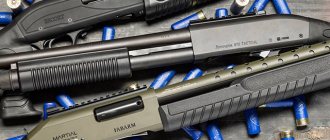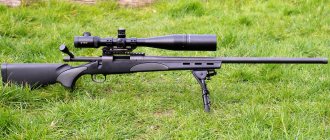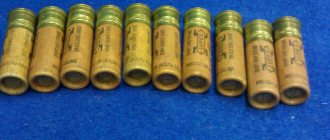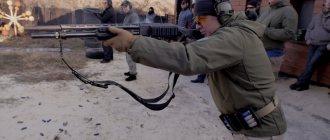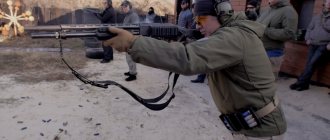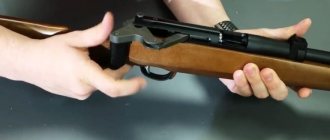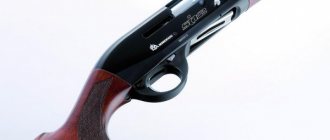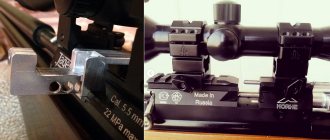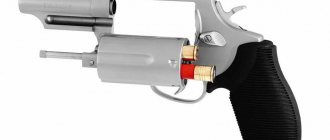Purpose of use
The main purpose of buying a pump-action shotgun is self-defense. It is not recommended to purchase a pump-action shotgun for self-defense without a firearms license. If it is used, the owner will have a difficult explanation with law enforcement officials.
A pump-action shotgun for self-defense has a number of advantages over other smoothbore shotguns.
The pump has a capacious under-barrel magazine for 4-8 rounds, in contrast to single-barreled or double-barreled hunting rifles with one and two cartridges, respectively.
Compared to semi-automatic guns, pump-action shotguns have a simpler and more reliable design.
The quality of rolling and the weight of gunpowder in the cartridge do not affect its performance. In the event of a misfire, the problem is corrected by jerking the movable forend and chambering a new cartridge into the chamber. The pump is the leader in the ability to fire the first shot when the weapon is completely unloaded. To do this, you need to throw the cartridge onto the feed tray and return the forend to the forward position. A weapon ready to fire appears in the hands of the defender. If time permits, you can equip the under-barrel magazine with one hand.
A good helper in this case will be a clip-on bandoleer. A butt bandolier is practical, but it changes the balance of the gun.
A bandolier for a receiver for 4-6 rounds is more versatile.
When you take the pump out of the safe, such cartridge belts will always have a supply of cartridges sufficient to end the conflict.
Below we will review the most suitable ones for self-defense.
Review of pump action shotguns. Pump-action weapons for hunting: the secret of popularity
PHOTO BY ANTON SCHMIDT.
Pump-action shotguns have become very widespread.
They have carved out a niche for themselves in the army, police, sports and have practically replaced other types of guns in the arsenal of self-defense fighters.
And, of course, such guns are popular among hunters.
In general, wherever you need a simple, high-quality, reliable and unpretentious weapon, you can find a pump-action shotgun of one design or another.
What is the secret of such popularity?
Simplicity and diversity are two parameters that combine in pump-action weapons and make them truly universal.
Pump-action guns can be either a classic hunting form, with a long barrel, replaceable chokes, or compact, for concealed carry (the latter, unfortunately, are prohibited in our country, with the exception of the traumatic “Terminator” version).
In Russia, pump-action shotguns are not as popular as in the USA, and primarily because of the cautious attitude of our hunters towards them. Pump-action engines fell into the class of “wrong” weapons along with Saiga.
Some hunters believe that it is absolutely impossible to hunt with a pump-action shotgun, and such arguments as “wrong type” and noisy reloading are used - the clanging of the mechanism when the bolt is pulled.
Of course, many arguments are far-fetched and of a taste nature. The appearance of pump-action shotguns is varied.
There are tactical shotguns with a pistol grip and in plastic, there are also classic models with a wood finish, with a long hunting barrel and interchangeable choke constrictions.
In addition, the design feature of pump-action shotguns allows you to quickly change the barrel. There are sets of weapons (usually called “combos”) that come from the factory with two barrels: one short, “bullet”, convenient for self-defense or hunting in the bush, the second long, for hunting waterfowl.
This option allows you to actually have two guns on one permit. You can replace the stock with a pistol grip and get a compact self-defense weapon, but in this case you need to pay attention to the overall length: when firing, civilian weapons in Russia should not be shorter than 80 centimeters.
| PHOTO LARRY BOZKA/FLICKR.COM (CC BY-NC-ND 2.0) |
Over more than a century of history, a huge number of pump-action shotguns have been invented and manufactured, differing not only in their external diversity, but also in their internal structure.
The manufacturer sought to create the most reliable and simple design. Thus, most often the bolt is locked “on a wedge”, that is, a small part is installed in the bolt itself, which, when the bolt is closed, rises and enters the corresponding hole in the barrel shank.
This simple and reliable solution, which came to us from Browning, occupies a dominant position. But it is far from the only one.
In the Winchester 1300, the bolt has a cylinder that locks the barrel by turning it, which complicated the bolt design, but simplified the production of the barrel and its fitting to the gun.
As we remember, a replaceable barrel is an important aspect of a pump-action weapon, and such a step can be fully justified, especially when there are demands for the interchangeability of all barrels of the same model.
| Locking the barrel by turning the cylinder is much less common on pump-action pumps. Photo by the author. |
An interesting detail is the cartridge feed tray. It doesn't get talked about much because on most guns it's really a tray that feeds the round from the magazine to the bolt feed line. But in Browning, its function is performed by two parts, and their work is a little broader and more interesting.
When the action is closed, these parts are at the top rather than at the bottom like the tray on other pump-action shotguns. At the same time, they are completely invisible and do not interfere with loading the magazine with cartridges. After retracting the bolt, they lower down, accept the cartridge and place it on the feed line.
When the bolt is closed and the cartridge is fed, they rise up again. But besides this obvious function, these parts also have the function of a reflector.
After a shot or when the bolt is opened, the cartridge or cartridge case is removed by the ejector, but does not hit the reflector, as in other weapons, but is hit with force by the “tray” parts. In my opinion, it is original and witty. What has the designer achieved?
And he achieved that the cartridge case extraction is always vigorous, and even if you turn the gun over, the cartridge case will still fly out of it without any problems. Moreover, the latter practically does not depend on the shutter speed.
Try slowly retracting the bolt with a regular reflector - after a time the cartridge case will not leave the bolt box at all.
Of course, this mechanism is due to another feature of the Browning: there is no window in the box for extracting the cartridge case, and loading and reloading of the weapon occurs through the only hole in the box - at the bottom. This is unusual, but the shooter quickly gets used to it.
Like classic semi-automatic shotguns, the most common type of magazine for pump-action shotguns is tubular.
There has been a long-standing and fierce debate on this matter. Of course, a box magazine is convenient for quick replacement, since with this type of ammunition you have as many cartridges in the gun as you have loaded magazines.
But all these arguments are good for sports or for tactical dreams. For hunting, magazine capacity and reloading speed are not so important.
If your magazine holds five rounds, this is more than enough, but a quick change of ammunition type feature, which is easy to implement on a tubular magazine, may be in demand.
Separately, it can be mentioned that weapons with a tubular magazine are more compact and easier to handle. In general, as with semi-automatic weapons, a tubular magazine for hunting weapons is convenient and understandable.
| PHOTO BY ANTON SCHMIDT. |
Separately, I would like to dwell on bullet barrels.
In Russia, bullet barrels are short and have no choke constrictions with pronounced sighting devices. It is really convenient to shoot any caliber or sub-caliber bullet from such barrels. But as smooth barrels they are also suitable for shooting buckshot and shot.
They often show excellent results when hunting from under a dog. Abroad, there are also rifled (fully rifled, not a “paradox”) barrels for pumps and semi-automatic machines of standard “smooth” calibers.
In Russia, they are practically never found due to the peculiarities of our legislation, since such weapons are rifled. As rifled competitors, they are not very strong; Let's face it: although you can shoot a heavy huge bullet accurately, it is relatively close, at a maximum of 200 meters.
On the one hand, this is an interesting experience, on the other hand, you get a small increase in distance, and only due to higher accuracy, but you lose the ability to shoot buckshot and shot.
Experiments show that when firing shot from a rifled barrel, the weapon produces a huge spread, reducing the effective shot distance to 10–15 meters.
A positive feature of a pump-action shotgun is its ability to use any cartridge of a given caliber. This works great and reliably on boosted and weakened charges.
You can use traumatic cartridges and cartridge cases of almost any length for which the chamber is designed, and the reloading algorithm will not change: fired, pulled the fore-end back and returned it forward - that’s it, the weapon is ready to fire.
No refusals or under-deliveries. It is this reliability that explains the popularity of pump-action guns in the USA, where hunters use them in almost all hunts: for feathers and for large and dangerous animals.
It is interesting that rifled weapons with manual reloading enjoy reverence and respect, but pump-action weapons, which are essentially weapons with the same manual reloading, on the contrary, cause disdain.
A curious situation arises with semi-automatic devices. It's strange when the same people use semi-automatic shotguns for hunting and completely reject pump-action ones. This phenomenon defies explanation.
| Photo by the author. |
Indeed, even in appearance these types of hunting weapons are very similar. What makes them different? A small gap between the fore-end and the frame, which, by the way, not all pump-action shotguns have? Or the lack of a charging handle?
Are these really signs that can be used to distinguish a “real” hunting rifle from a “wrong” one? I think there's something else going on here. In my opinion, this is simply a rejection of something unusual and inconvenient for you.
But despite the rejection, there is a large group of hunters in our country who consider pump-action weapons to be absolutely complete and convenient. They hunt with him and enjoy it.
I am close to the idea that a hunting weapon is the one with which one hunts. Pump-action weapons have come a long way, with more than a hundred years of active use in all conditions and a large number of fans behind them. Isn't this the best proof of its right to be considered a real hunting weapon?
Speaking of pumps, one cannot ignore their military modifications. It is this direction and, of course, its use by the police that confirms the high reliability of this type of weapon and the ease of its operation.
For the first time, pumps were used as military weapons in the US Army. It was either an independent weapon along with a rifle, or an addition to it. It was used when storming enemy trenches.
In trenches and trenches the range was short, and the shotgun's enormous stopping power was a noticeable advantage. In addition, pump-action weapons had a higher rate of fire than manually loaded rifles. It was the pump-action weapon that received the name “trench broom”.
| Wedge locking is one of the most common; it is easily recognized by the cutout in the barrel shank. Photo by the author. |
The ergonomics and reliability of pump-action weapons were honed on the battlefield. So, in order to increase the rate of fire, a self-timer was added to the mechanism of the army Ithaca.
It worked as follows: the fighter pressed the trigger and moved the forend back and forth; as soon as the bolt was locked, the trigger itself was released from the cocking position and a shot was fired.
With just a little practice, the fighter could shoot accurately at close ranges with the rate of fire of a submachine gun.
Two options took root in the army: as the main weapon - a gun with a butt (in this case, a bayonet could be attached to it) and as an auxiliary - a gun with a pistol grip and a shortened barrel.
The demand for the pump in the police is explained by the possibility of using various ammunition, including special ones (for example, for knocking out locks), and the low barrier effect of cartridges with buckshot, which is good where houses are built from materials that are easily penetrated through by a rifle bullet.
Alexander Kudryashov May 11, 2022 at 10:53 am
Remington 870 (USA)
An exceptionally reliable pump-action weapon. Available in 12, 16, 20, 28 calibers. For self-defense, a modification with a barrel length of 510 mm is suitable.
Receiver made of steel. Tubular magazine with a capacity of 3 or 8 rounds with a magazine extension.
High quality workmanship, a large number of additional accessories: a polymer folding stock, a pistol grip, a forend and a receiver with Picatinny rails (this bracket allows you to attach a flashlight, a laser target designator, a collimator sight to a weapon).
Read about which self-defense weapons do not require a permit or license in this article.
In this article you can read about the best models of air pistols for self-defense.
Benelli Super Nova
Each of these guns has its own “zest” and subtleties. Everyone has both strengths and hidden weaknesses. But how can an inexperienced shooter understand what these guns really are?
This article was written precisely to help Ukrainian shooters in this difficult, at first glance, choice. Let's take all the listed samples and find out whether they are as good as foreign marketers position them? And for clarity, we use a ten-point scale and evaluate their qualities (the maximum total score is 100, for 10 parameters).
Since all these guns are smooth-bore weapons with manual reloading with a longitudinally sliding fore-end, we will begin the comparison with its assessment.
MR-133 (Russia)
The most popular pump-action weapon in Russia. Equipped with a triple shot protection system.
Receiver made of aluminum alloy. Caliber 12/70, 12/76, 12/89 mm. For self-defense purposes, a barrel with a length of 510 or 540 mm is preferred.
Magazine capacity is 4 rounds, with a magazine extension - 8. Options: with a wooden butt, with a plastic folding butt and pistol grip, with a pistol grip. Since 2013, it has been replaced by a more advanced model MP-135.
FOREND
Mossberg 590 – the handguard is short and located far away. First of all, it is comfortable for shooters with long arms, but others will have to get used to it or change to a different handguard. It has powerful corrugation, which, together with the rounded shape of the fore-end, allows you to securely hold the weapon during manipulation.
Optionally, a longer forend can be installed.
The forend rods are separate and spring-loaded.
Score: 7 points.
Remington 870 - The handguard is short and just as far back as the Mossberg. Due to such an extension of the fore-end, the shooter’s hand (especially for beginners) quickly gets tired and begins to tremble, which leads to a decrease in shooting accuracy (primarily, of course, this applies to athletes from the IKPS). Optionally, a longer forend can be installed.
The forend rods are separate and spring-loaded.
Score: 7 points.
Benelli Super Nova - equipped with a long forend. Due to its size, there is no distortion during translational movement, which contributes to less wear on the guides. You can use different grip options (close-to-far), which makes the gun equally comfortable for shooters with different arm lengths. The shape of the forend is very ergonomic, allowing the use of different grips.
The forend rods are separate and spring-loaded.
Score - 10 points.
Fabarm SDASS - like the Super Nova, it has a long fore-end, but it is simpler in shape and not ergonomic. The handguard is comfortable for shooters with different arm lengths.
In some SDASS versions, the forend may have a return spring, which makes it easier for the shooter to return the forend to its original position after firing. At first glance this is good. The subtlety is that such a system requires some getting used to and does not always allow the shooter to clearly use the energy of the shot for a quick reload.
And the first disappointment is that Fabarm’s fore-end rods are combined with the platform on which the bolt cylinder is mounted. In this regard, during intensive use, increased wear of the rods and receiver guides occurs. And this is a question of weapon reliability.
Score - 6 points.
Hatsan Escort AimGuard (Türkiye)
Positioned by the manufacturer as a self-defense weapon. It is distinguished by good reliability and decent workmanship at a low cost. Caliber 12/76 mm. Barrel length – 450 or 500 mm. Magazine capacity – 5 or 7 rounds. The handguard and butt are plastic.
There are options with a metal folding stock and a pistol grip, and with a pistol grip without a stock.
A pump-action shotgun is a formidable and effective weapon for self-defense. It is suitable for solving most problems of ensuring the safety of yourself and your family, as well as your territory.
Watch a video review of a pump-action weapon, an expert will tell you how a pump differs from a semi-automatic weapon and a lot of other useful information for choosing a shotgun:
SHOP
Mossberg 590 is the leader in this comparison in terms of basic magazine capacity. Initially, the standard version can load 8+1 shotshells. An extension cord can be used as an option.
Score - 10 points.
Remington 870 - In the standard version of shotguns sold on our market, magazine capacity: 7+1 shotgun cartridges. An optional magazine extension can be used.
Score - 8 points.
Fabarm SDASS - Depending on the modification, the magazine capacity can be up to 7+1 shot cartridges. It is possible to equip the gun with a magazine extension.
Score - 8 points.
Benelli Super Nova - basic magazine capacity: 5+1 shotshells. Optionally, you can install a magazine extension of various capacities (up to 12 rounds).
Among the highlights, it is worth noting the “Mag-stop” system, which is an exclusive BENELLI patent. It allows you to easily remove one cartridge at a time from the magazine, while leaving the remaining cartridges in place. A very serious plus, since you can quickly replace a cartridge (for example, a shotgun with a bullet) with fewer manipulations with the weapon.
Score - 5 points.
MAGAZINE LOADING WINDOW TRAY
Benelli Super Nova - has a unique tray design. When feeding the first cartridge into the magazine, the tray is fixed in the upper position and does not interfere with subsequent loading of the magazine.
Score - 10 points.
Mossberg 590 is a patented cartridge feed mechanism design. The tray is missing. When loading the magazine, absolutely nothing interferes with the shooter. But you will have to get used to the fact that when quickly loading cartridges into the magazine, you can damage your finger on one of the sharp edges.
Score - 8 points.
Remington 870 and Fabarm SDASS - the tray is included in the design.
The disadvantage identified when using Remington and Fabarm showed that such a design when loading a magazine leads to regular “pinching” of the shooter’s fingers by the tray (often leading to hand injuries). In addition, if the chambering is unclear, the cartridge may fall out onto the tray, which leads to double feeding of the cartridge.
Score: 6 points each.
CONCLUSIONS
Remington 870 - 72 points and cost from 5200 hryvnia. This model, produced without much change since 1950, is a traditional example of a pump-action shotgun - simple and unpretentious. Unfortunately, Remington remained stagnant for too long. And the popularity of the model was maintained mainly by fans of the brand. But everything is changing and today it is obvious that the 870 model is increasingly difficult to compete with its rivals.
Fabarm SDASS - 73 points, with a price starting from 6,500 hryvnia. Having scored approximately the same points with the old school representative from Remington, however, the SDASS model could not surprise with anything other than technical shortcomings and ambitions expressed in aggressive marketing, as well as a more inflated price. Having invested in fashionable tactical design, the creators of Fabarm did not bother to effectively use the advantages and experience of previous generations of pump-action shotguns. With such an imbalance of qualities, this gun will probably only be able to impress a person who cares only about the fashionable appearance of the gun on the display.
Mossberg 590 - 77 points, price from 5200 hryvnia. The 590 model did nothing to surprise or disappoint. This is still the same reliable and unpretentious workhorse, which will fit both a beginner and a fully experienced shooter. In recent years, the Mossberg 590 has earned recognition in IPSC shooting sports for its affordability and high durability at high ranges.
Benelli Super Nova - 94 points, price category from 9200 hryvnia. The leader of this review, which proved to be the best in almost all test categories. Yes, it’s fair to say that the Super Nova stands somewhat apart due to its higher price. But at the same time, it is the best pump in the world today, leaving its competitors far behind. The creators of this gun took into account all the shortcomings of their predecessors, developing a very high-quality, balanced and reliable weapon.
COMFORTABLE ASSEMBLY/DISASSEMBLY OF WEAPONS
A very important nuance that novice shooters who are not yet experienced in the intricacies of working with weapons do not always think about. Meanwhile, it is precisely this factor that can become a pitfall that is inconspicuous at first glance.
Benelli Super Nova - showed itself very worthy in this comparison, showing the most comfortable disassembly/assembly. It is very easy to remove the trigger block and bolt body for cleaning. Disassembling the bolt itself also does not cause the slightest difficulty. We can confidently summarize that this will not cause the slightest problem for the owner.
Score - 10 points.
Fabarm SDASS — Disassembly/assembly of this Italian gun turned out to be quite simple, but the difficulty of disassembling the face was disappointing, which overall somewhat spoiled the impression.
Score - 8 points.
Mossberg 590 and Remington 870 - The level of disassembly/assembly of the gun can be assessed as average. But disassembling the shutter itself is quite difficult. It is worth noting that modifications of the Remington 870, which have a conventional phosphated coating, are very demanding in terms of constantly cleaning all metal surfaces from moisture and powder deposits. Otherwise, the gun may become spotted with spot rust within a few hours after shooting or being in unsuitable conditions.
Score: 7 points.
SIGHTS
Benelli Super Nova - depending on the version of the gun, you can purchase a barrel with either a bullet sighting device (diopter/front sight, rear sight/front sight) or with a classic rifle sighting device (high rib/front sight). Optional installation of “light-collecting” front sights of various configurations is available.
Super Nova is the only one on this list that has a modification with a high rib.
An advantage of the SLUG bullet barrel is the sight, which is slightly shifted back (compared to classic bullet sights), which increases the length of the aiming line and slightly improves aiming accuracy.
Score - 10 points.
Mossberg 590 and Remington 870 - depending on the version, you can purchase a barrel with both a bullet sighting device (rear sight/front sight) and a classic front sight. Optional installation of light-collecting front sights is possible, but the choice is limited.
Each score is 7 points.
Fabarm SDASS - Depending on the design, there may be barrels with a classic front sight or with a bullet sighting device (diopter/front sight, rear sight/front sight). Optional installation of light-collecting front sights is possible, but the choice is limited.
Score - 8 points.
Specialist's note: sights with a diopter (ghost ring) and a high front sight look, of course, very impressive to a person inexperienced in shooting. At first glance, this is justified from a shooting point of view. After all, the diopter gives higher accuracy when shooting a bullet. But there is one subtlety - since the sight and front sight are too large (this is especially noticeable on the Fabarm), their size overlaps the shooter’s field of view too much (especially in conditions of insufficient visibility - in twilight or darkness). It’s extremely difficult to call this a plus.
And they rarely shoot bullets from pumps, and their main purpose is buckshot/shot at distances of 5-35 meters. Obviously, a diopter is absolutely unnecessary at such distances. But the vertical bar will be optimal and will allow you to quickly transfer fire from target to target.
